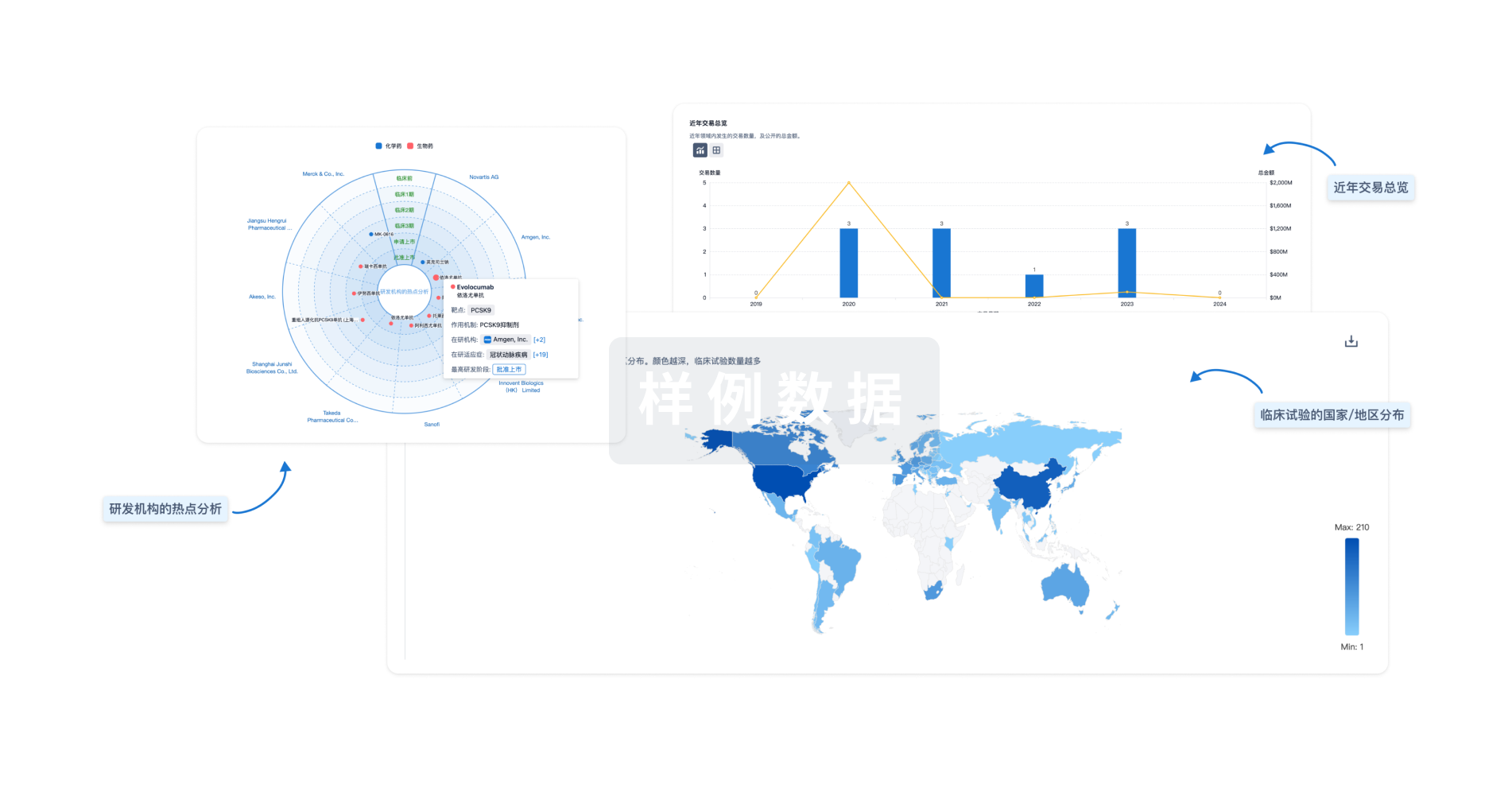预约演示
更新于:2025-05-07
ERMAP
更新于:2025-05-07
基本信息
别名 BTN5、ERMAP、erythroblast membrane associated protein (Scianna blood group) + [6] |
简介 Possible role as a cell-adhesion or receptor molecule of erythroid cells. |
关联
100 项与 ERMAP 相关的临床结果
登录后查看更多信息
100 项与 ERMAP 相关的转化医学
登录后查看更多信息
0 项与 ERMAP 相关的专利(医药)
登录后查看更多信息
991
项与 ERMAP 相关的文献(医药)2025-08-01·Current Opinion in Genetics & Development
From conservation to adaptation: understanding the synaptonemal complex’s evolutionary dynamics
Review
作者: Hawley, Robin Scott ; Williams, Stefanie
2025-04-01·Mycoses
Clinical and Hospital Environmental Fusarium in Taiwan: Molecular Identification, Antifungal Susceptibilities, and Phylogenetic Analyses
Article
作者: Chen, Yi‐Chun ; Kuo, Shu‐Fang ; Lee, Susan Shin‐Jung ; Sun, Pei‐Lun ; Wu, Chi‐Jung ; Hsieh, Ming‐I ; Lee, Chen‐Hsiang ; Lin, Yin‐Shiou ; Ou, Jie‐Hao
2025-03-26·The Journal of Neuroscience
Pmp2+ Schwann Cells Maintain the Survival of Large-Caliber Motor Axons
Article
作者: Schmidt, Robert E ; Benitez, Ana Morales ; Strickland, Amy ; Milbrandt, Jeffrey ; Kozlowski, Mikolaj M ; DiAntonio, Aaron ; Bloom, A Joseph
9
项与 ERMAP 相关的新闻(医药)2024-10-28
IND2025主会场授课已被预定,大会第一天下午茶歇前授课时间段预定开始,咨询热线:177 0186 0390。点击图片,查看IND2024会后报告
疼痛药物拥有巨大的市场潜力,对于疼痛的治疗需要根据其病因选择合适的治疗方法。根据疼痛的发病机制可以将其分为四类:伤害性、炎症性、神经性和功能失调性疼痛。 伤害性疼痛是由外周伤害感受器检测到有害的组织损伤刺激后被激活而引起的,刺激的持续存在可导致骨关节炎等病理状态。伤害性疼痛的治疗包括阻断伤害感受器感受外界刺激,如TRPV1和TRPA1;阻断感受器的动作电位传输,如Nav1.7和Nav1.8;用N型钙通道阻滞剂或神经递质受体拮抗剂阻断伤害感受器向大脑和脊髓的刺激传递;用阿片类药物阻断皮层区域激活。
炎症性疼痛是一种由组织损伤引起的疼痛,它引起免疫细胞和受损细胞的伤害感受器的激活。因此,通过非甾体抗炎药(NSAIDs)和环氧化酶2 (COX-2)抑制剂可以减少前列腺素E2的产生,免疫反应的降低可以减轻炎症性疼痛。
神经性疼痛不是病理的症状,而是神经系统损伤引起的周围和中枢神经系统病理改变的结果,并且疼痛通常在病理治疗后仍然存在。神经性疼痛可由糖尿病、化疗、脊髓损伤、神经创伤和中风等引起。治疗策略包括通过加巴喷丁类药物减少兴奋,增加双胺摄取抑制剂的抑制,或拮抗N-甲基-D-天冬氨酸(NMDA)受体。
功能失调性疼痛是由除以上三种因素引起的疼痛,主要是由于机体的功能失调而引起的,如纤维肌痛、肠易激综合征和颞下颌关节紊乱等。
止痛药发现的努力是针对每种类型的疼痛量身定制的。除了关注促进有效镇痛外,疼痛药物发现工作还应关注提高治疗率和避免耐受性和强化效应。疼痛也可以分为急性和慢性。急性疼痛是由损伤或疾病引起的,与骨骼肌痉挛和交感神经系统激活有关。急性疼痛具有有用的生物学目的,一旦疾病或损伤得到治疗,疼痛就会消失。另一方面,慢性疼痛比疾病或损伤持续的时间更长,被认为是一种独立的疾病状态。慢性疼痛可能源于心理状态,没有生物学目的,没有可识别的终点,治疗需要多学科的方法。
尽管努力开发新的更安全的镇痛药,但是阿片类药物和阿司匹林等非甾体抗炎药(NSAIDs)仍然是治疗疼痛的主要药物,其他用于治疗疼痛的药物包括三环抗抑郁药(TCA)、抗惊厥药(加巴喷丁类)、NMDA受体拮抗剂和曲坦类药物。在过去的一个世纪里,对疼痛机制的理解增加了,导致了一些靶点的确定,包括受体,如α2-肾上腺素能,大麻素,γ-氨基丁酸(GABA),5-羟色胺(5-HT)1B/D,NMDA,阿片,TRPV1和降钙素基因相关肽(CGRP)受体等;酶,如COX-2和sepiapterin还原酶和离子通道,如电压门控钠通道。目前,阿片类药物仍然是治疗急性疼痛的主要药物,因此,应继续努力开发更安全的阿片类药物。
一、 开发更安全的阿片类止疼药
阿片样受体属于7次跨膜G蛋白偶联受体(GPCR)的超家族,分为mu、kappa和delta阿片样受体(分别为MOR、KOR和DOR) 。阿片类药物是唯一被证明对治疗大多数人群疼痛有效的药物类别。然而,阿片类药物在治疗神经性疼痛方面效果较差,并且会产生诸如耐受性、成瘾性、呼吸抑制、便秘、恶心和嗜睡等不良反应。由于与阿片类药物相关的这些问题,药物的发现工作已被用于开发副作用较小的阿片类药物疗法。这些方法包括开发偏向性阿片受体激动剂,多功能阿片受体,阿片受体的变张调节剂,以及使内源性阿片肽药物化。
1.1 阿片受体变构调节剂
变构调节剂结合在受体的变构位点,可以调节正构配体与受体的亲和力以及生物学效应。变构调节剂根据其对正构位点活性的影响可以分为正变构调节剂,负变构调节剂和静默变构调节剂。正变构调节剂增强了正位位点配体的结合亲和力和/或功效,而负变构调节剂降低了正构位点配体的结合亲和力和/或功效。静默变构调节剂不对正构位点活性产生任何影响,但是它可以竞争性拮抗正负变构调节剂。
MOR的正变构调节剂可用于增强阿片激动剂如吗啡和内源性阿片的效力,并降低产生镇痛所需的剂量,因此MOR的正变构调节剂被开发用于提高疗效降低副作用。BMS-986121 ,BMS-986122和BMS-986187已报道的MOR正变构调节剂。
1.2 偏向激动剂 通常,GPCR与一个或多个异源三聚体G蛋白功能偶联,然而,现在已经证明GPCR可以介导多种信号通路,如β-抑制素信号通路。能够选择性地通过一个途径而不是另一个途径发出信号的化合物被称为“功能性选择性”或“偏倚性”激动剂。阿片样物质通过G蛋白级联和β-抑制素途径发出信号。偏向性激动剂可以优先通过G蛋白信号传导,增强镇痛,减少呼吸抑制、耐受和依赖等不良反应。MOR的偏向激动剂Oliceridine 已被批准上市,与吗啡相比,拥有更好的治疗指数。进一步增加G蛋白信号传导对β-arrestin2信号传导的偏好可能会导致新型阿片类药物治疗疼痛的发展并显著减少不良反应。
1.3 双位/二价阿片受体的配体
二价配体是含有两个药团的化合物,两个药团由大小/长度不同的连接体分开,连接体可以是刚性的或柔性的。这两种药效团可以是相同的(同二价)或不同的(异二价)。代表性分子有MDAN-21,CYM51010,NNTA和INTA等。
1.4 阿片肽类似物
阿片肽类似物主要是模拟内源性的阿片肽,其代表性结构有以下两个化合物:
二、NMDR受体拮抗剂
NMDA受体是一种配体和电压调节离子通道,位于突触后膜,几乎在所有脊椎动物突触中表达,调节Na+和Ca2+离子的通透性。NMDA受体属于嗜离子性谷氨酸受体家族(iGLuR),在神经元发育、可塑性、和存活中起重要作用。NMDA受体的过度刺激引起高Ca2+内流,从而促进兴奋性毒性,发条现象和中枢致敏,这可能导致急性和慢性疼痛状况的发展。4因此,NMDA受体拮抗剂可用于减轻痛觉。 氯胺酮(Ketamine )是已知的NMDA受体拮抗剂,用于治疗急性和慢性疼痛。美沙酮(Methadone),金刚烷胺(amantadine)和美金刚(memantine)也能拮抗NMDA受体,产生止痛作用。右美沙芬(Dextromethorphan)可拮抗NMDA受体并在几种慢性疼痛情况下产生镇痛作用。新型的NMDR受体拮抗剂NYX-2925 和RL-208 也被报道。
三、非甾体抗炎药
非甾体抗炎药是世界范围内使用最广泛的非处方药(OTC)和处方药。非甾体抗炎药是治疗许多炎症性疾病的首选药物,如关节炎、肌肉和关节损伤。这些药物也用于治疗一系列急性和慢性疼痛,包括轻微疼痛、月经痉挛、术后疼痛和偏头痛。非甾体抗炎药通过阻断参与前列腺素合成COX-1和COX-2的活性来产生抗疼痛作用。包括非选择性COX抑制剂,如阿司匹林,双氯芬酸,布洛芬和萘普生等。选择性COX-2抑制剂,如塞来昔布,罗非昔布和伐地昔布等。一些包含非甾体抗炎药和碳酸酐酶活性的化合物也被报道,如29和30。
四、去甲肾上腺素转运蛋白(NET)抑制剂
NET属于Na+/Cl -依赖转运蛋白家族,可以转运血清素、多巴胺、甘氨酸和GABA等。它是一种位于交感神经元上的突触前转运蛋白,参与去甲肾上腺素信号的失活,这对于防止去甲肾上腺素的不成比例的升高至关重要。因此,NET可以调节大脑中的肾上腺素能神经传递以及周围器官。NET抑制剂在多种精神疾病中发挥重要作用,包括焦虑、抑郁、精神分裂症、肥胖和慢性疼痛。
度洛西汀(Duloxetine)和米那普仑(milnacipran)是血清素(SET)转运体和NET转运体的双重抑制剂,被批准用于治疗重度抑郁症,有效缓解慢性疼痛,如纤维肌痛、骨关节炎和糖尿病性神经病变。最近,一种新的选择性NET抑制剂TAS-303和双重NET和SET抑制剂ZY-1408分别对疾病如抑郁症和压力性尿失禁有效。因此,应该继续努力筛选新型NET抑制剂治疗慢性疼痛。
除了上述四类经典的靶标外,还有一些较新的靶标处于开发状态,包括一些受体,离子通道和酶。
血管紧张素Ⅱ受体 血管紧张素II因其在肾素-血管紧张素系统(RAS)中的作用而闻名,RAS与脉管系统、心脏、肾脏和大脑有关。在多种细胞和组织类型中,血管紧张素Ⅱ以相似的亲和力结合GPCR亚型血管紧张素II 1型和2型受体(分别为AT1R和AT2R)。除了控制血压外,血管紧张素Ⅱ在神经性疼痛中起重要作用,AT1R拮抗剂和AT2R配体均产生镇痛作用,AT2R配体产生的不良效应比AT1R拮抗剂少。AT1R拮抗剂坎地沙坦(candesartan)和氯沙坦(losartan)减轻了神经性疼痛模型中的异位性疼痛和痛觉过敏。两项多中心、随机、双盲、2b期研究证实了AT2R拮抗剂EMA401对减轻疼痛性糖尿病神经病变患者疼痛强度的临床疗效。AT2R拮抗剂EMA 200和激动剂C21均可产生抗疼痛作用。目前正在研究血管紧张素 II受体的选择性激动剂和拮抗剂,以开发新型镇痛药。
降钙素基因相关肽(CGRP)受体
CGRP是一种中枢和外周作用的神经肽,具有强大的血管扩张作用的神经递质,涉及几种疼痛途径,特别是偏头痛。Erenumab(一种单克隆抗体),由Amgen和Novartis开发,是FDA批准治疗偏头痛的首个CGRP拮抗剂(2018年)。虽然olcegepant是第一个开发的小分子高亲和CGRP受体拮抗剂,但的Ⅰ期临床试验已停止。其他小分子CGRP受体拮抗剂,如ubrogepant和rimegepant,分别于2019年和2020年获得FDA批准用于治疗偏头痛。另一种小分子CGRP受体拮抗剂BI 44370 TA。目前正在美国和欧洲进行临床试验。
溶血磷脂酸(LPA)受体
LPA是一种小溶血磷脂,含有一个磷酸甘油头基团和一个单一的脂肪酸片段,在中枢神经系统的发育和生理中起重要的作用。LPA具有高亲和力结合并激活被称为LPA受体的GPCR。LPA受体分为六个亚型(LPA1 - 6)。LPA的产生和信号传导通过作用于神经元和免疫细胞,在诱导神经性疼痛中起重要作用。因此,针对LPA受体或产生LPA的酶,可能用于神经性疼痛的治疗。事实上,据报道,LPA1和LPA3受体介导小鼠糖尿病神经性痛觉过敏和痛觉减退的发生。已确定的LPA受体拮抗剂包括Ki-16425(非选择性)和ONO-9780307 (LPA1受体选择性)。Ki-16425能阻断LPA诱导和部分坐骨神经结扎神经性疼痛模型的异动行为。使用强效LPA1受体拮抗剂BMS-986020进行的2期临床试验表明,LPA1受体拮抗剂有效治疗特发性肺纤维化;然而,研究因肝毒性而终止。化合物如49和UCM-05194是LPA1激动剂也已被在小鼠免于神经损伤(SNI)神经性疼痛模型中,显示出显著的减轻神经性疼痛的疗效。因此,阻断LPA1受体的LPA1拮抗剂和导致受体脱敏的LPA1激动剂都可以用于神经性疼痛的新型治疗。
Nav1.7 and Nav1.8
编码Nav1.7的SCN9A 基因发生沉默突变时,病人感觉不到疼痛,但具有触觉和压力敏感性,嗅觉丧失,并且对组胺引起的瘙痒没有反应,而该基因发生功能获得性突变时,患者会发生极度疼痛障碍如阵发性极度疼痛障碍和外周性红斑性肢痛症。非选择性Nav抑制剂,包括利多卡因、美西汀、和卡马西平,对慢性疼痛有临床疗效。然而,由于部分不参与疼痛信号传导Nav亚型介导的不良效应,这些药物的临床应用受到限制。例如,抑制中枢神经系统表达的Nav1.1会导致中枢神经系统相关的不良反应;抑制心肌细胞中Nav1.5可诱导不良的心血管效应。目前为止,已报到了9个亚型,即Nav1.1~1.9。选择性Nav1.7抑制剂DS1971a在小鼠中对神经结扎引起的热和机械超敏反应具有镇痛作用,其他报道的选择性Nav1.7抑制剂有PF-05089771,PF- 05150122 ,PF-05186462 和XEN402 。但是在疼痛性糖尿病周围神经病变患者的临床试验中,PF-05089771 不能减轻疼痛,但能减轻灼烧感觉。XEN402能减轻遗传性红斑性肢痛症患者的疼痛。此外,选择性Nav1.7拮抗剂GX-201的研究显示,其体内停留时间较长,对炎症性和神经性疼痛的疗效有所改善,这表明Nav1.7抑制剂在临床研究中的失败可能是由于高血浆蛋白结合或高血浆清除率等药物特性差,导致靶点占用不足。对Nav1.7抑制剂的开发应该追求部分抑制剂,因为完全消除病人对疼痛的正常反应。
由SCN10A基因编码的Nav1.8似乎在疼痛的病理生理中发挥作用,且可能会消除中枢神经系统的不良反应,因为它位于中枢神经系统外的背根神经节。Nav1.8选择性阻断剂A-803467能够削弱大鼠的神经疼痛和炎症疼痛。因此,共同靶向参与伤害性传递的Nav通道,如Nav1.7、Nav1.8和Nav1.9,或开发高选择性Nav抑制剂仍然是开发新型镇痛药的可行途径。
神经紧张素(Neurotensin )
神经紧张素结合三种受体:神经紧张素1、2和3 (NTSR1、NTSR2和NTSR3)。神经紧张素通过NTSR1/2s介导伤害性反应,例如,非选择性NTSR1/NTSR2激动剂ABS212, JMV2007, JMV2009和NT69L在啮齿动物急性疼痛模型中产生抗伤害性反应,该作用NTSR1/2拮抗剂SR48692逆转。NTSR1激动剂PD149163和NTSR1 PAM PP-001均在大鼠急性和慢性疼痛模型中产生镇痛作用。如前所述,NTSR1和NTSR2激动剂均可产生镇痛作用,然而,神经紧张素的不良反应如低温和低血压是通过NTSR1激活介导的。最近有报道选择性NTSR2激动剂JMV431在大鼠的甩尾、福尔马林和CFA试验中产生抗痛感而不诱导低温。CGX-1160是一种神经紧张素a类似物,在脊髓损伤后中枢性神经性疼痛患者的Ⅰ期临床试验中产生抗痛觉作用。因此,高度选择性神经紧张素受体激动剂仍然是开发具有低滥用潜力的新型镇痛药的可行途径。
P2X3和P2X7嘌呤受体拮抗剂 除了作为细胞代谢的主要能量来源外,三磷酸腺苷(ATP)还通过激活P2X3和P2X7嘌呤能受体调节神经传递。ATP是一种伤害性调节剂,它作用于外周和中枢增强过程,导致超敏反应。选择性P2X3受体拮抗剂A-317491,其选择性比其他P2受体高100倍以上,在炎性疼痛的CFA模型和神经损伤的CCI模型中产生抗疼痛感觉。另一方面,A-317491在有害刺激的急性伤害感觉模型中不产生抗伤害感觉,这表明P2X3受体仅在组织受伤或致敏时有反应。P2X7受体拮抗剂A-438079在类似于P2X3受体拮抗剂的致敏条件下产生抗伤性。除了P2X3和P2X7拮抗剂外,P2Y14受体拮抗剂66和67在CCI诱导的神经损伤小鼠模型中逆转了慢性神经性疼痛。P2X3、P2X7和P2Y14受体可能是开发新型非阿片类镇痛药的理想靶点。
电压门控钾Kv7通道
电压抑制的K+通道在控制神经元兴奋性中起重要作用,打开神经元Kv7通道的化合物对动作电位启动有抑制作用,因此它们在神经性疼痛中具有应用潜力。氟吡汀(Flupirtine)是Kv7钾通道的开启剂,用于治疗对非甾体抗炎药或阿片类药物难治的患者的疼痛。Kv7.2负性突变的小鼠对疼痛的敏感性强于野生型。Kv7.2抑制剂XE991会增强小鼠痛感,这种增加作用可被Kv7离子通道开启剂retigabine所挽救。其他Kv7.2离子通道开启剂如71、ICA-27243和SCR2682在啮齿动物急性伤害性疼痛模型中产生抗痛觉性。此外,在使用福尔马林试验的等密度分析研究中,观察到Flupirtine和吗啡之间的协同作用。
GPR18,35,55 与GPR18相关的信号传导机制尚未完全建立,该受体介导的生理功能尚未完全了解。已经提出了许多GPR18的激动剂,包括Abn-CBD,Δ9-tetrahydrocannabinol,O-1918,N-arachidonoyl glycine , resolvin D1 和resolvinD2。这些化合物与大麻素相关,表明GPR18可能与CB1和CB2一起被归类为大麻素受体。。PSB-CB5是通过分子建模和计算研究发现的首个有效的GPR18拮抗剂。PSB-KK-1415被发现是一种有效的、选择性的GPR18激动剂,据报道在炎症性疼痛的动物模型中发挥抗炎和抗伤害性作用。选择性GPR18配体仍然是目前项目的重点,旨在发现安全有效的镇痛药。
GPR35参与了许多疾病,如疼痛、高血压和癌症。虽然GPR35的内源性配体尚不清楚,但色氨酸代谢物kynurenic acid、2-acyl lysophosphatidic acid和趋化因子CXCL17被认为是GPR35的内源性配体。GPR35激动剂,包括bufrolin、cromolyn、lodoxamide和zaprinast。在小鼠坐骨神经损伤实验中,化合物kynurenic acid和zaprinast降低热和触觉超敏反应,增强吗啡治疗神经性疼痛的疗效。已报道的GPR35拮抗剂包括ML-145和CID2745687。鉴定GPR35的激动剂和拮抗剂不仅有助于了解GPR35的生理学,而且有助于开发新型镇痛药。
GPR55与嘌呤受体和趋化因子受体家族有关,可能是一个非典型的大麻素受体,因为它的氨基酸与两种大麻素受体CB1和CB2序列同源性较低。GPR55的第一个假定的内源性配体是磷脂溶磷脂酰肌醇,激动剂包括Abn-CBD, Δ9-tetrahydrocannabinol,2-AG,N-arachidonoylethanolamine和O-1602,拮抗剂有CID16020046 和SR141716A 。GPR55刺激产生炎症性疼痛,因此暗示GPR55是疼痛的治疗靶点。
HMGB1
HMGB1是一种没有特异性配体的炎症生物标志物,其在抗疼痛感受中的作用仍有待阐明。然而,现有证据表明,HMGB1的抑制导致异位性疼痛的减少。HMGB1抑制剂glycyrrhizin在小鼠炎症性疼痛模型中产生减轻机械异常性痛和热痛觉过敏。另一种HMGB1释放抑制剂丙酮酸乙酯,减轻了小鼠急性胰腺炎伴随的胰腺痛感过敏。目前已经开发的针对HMBG1的化合物有限,因此,药物化学应继续努力追求高选择性HMBG1抑制剂,因为这些化合物可能导致新型镇痛药的开发。
神经营养生长因子(NGF)和原溶酶受体激酶A(TrkA)
NGF通过诱导痛觉过敏在疼痛信号的传递中起作用,以高亲和力与TrkA的细胞外结构域结合,并以低亲和力与75 kDa的神经营养因子受体p75结合,导致一系列事件,这些事件负责NGF的生理效应,包括其促疼痛特性。人源化抗NGF抗体RN624的 3期临床试验目前正在进行中,用于治疗骨关节炎、慢性腰痛和癌症疼痛。NGF-TrkA途径的小分子药物发现工作主要集中在开发结合NGF、拮抗TrkA受体或抑制TrkA激酶活性的化合物。化合物ALE-0540、PD90780和Ro 08-2750与NGF结合,阻止NGF与TrkA和p75的结合。第一批开发的TrkA激酶抑制剂主要是泛Trk抑制剂,具有显著的脱靶激酶活性和不良反应。pan-Trk抑制剂的例子包括103和PF-06273340(104)。这些化合物在CFA诱导的疼痛模型中显示出剂量依赖性的抗痛觉性,其疗效高于非甾体抗炎药。三个Trk亚型的x射线晶体结构从2012年开始被解决,这导致使用基于结构的药物设计开发对TrkA选择性优于TrkB和C.的化合物。Array BioPharma使用诱导拟合方法和基于结构的药物发现开发了选择性TrkA抑制剂AR786。默克公司还报道了一种选择性TrkA激酶抑制剂106,其选择性分别比TrkB和TrkC高230倍和190倍。其他尚未披露结构的TrkA选择性抑制剂包括CT340、GZ389988、vm902a和Ono-4474。抗NGF疗法在临床试验中的成功,刺激了靶向NGF-TrkA通路的发展。虽然NGF/TrkA通路产生抗痛觉的机制尚未完全阐明,但已经提出TRPV1通道、AT2R和鞘氨醇-1-磷酸(S1P)受体可能参与其中因此,靶向NGF/TrkA通路和上述受体仍然是开发新型镇痛药的可行途径。
Sepiapterin还原酶(SPR)抑制剂
SPR是参与合成(6R)-L-erythro-5,6,7,8-tetrahydrobiopterin (BH4)的末端酶,BH4是芳香族氨基酸羟化酶、烷基甘油单加氧酶和一氧化氮合酶等酶的重要辅因子。在啮齿动物模型中,BH4水平升高与更大的疼痛和过敏有关。因此,抑制SPR可能是开发新型镇痛药的可行途径。SPR的x射线晶体结构揭示了其抑制剂Nacetylserotonin(NAS)的结合袋,这有助于SPR抑制剂的药物设计。SPRi3在神经性疼痛SNI模型小鼠中产生剂量依赖性抗触觉异动效应,并在神经性疼痛慢性CCI模型小鼠中降低机械异动。化合物108显著减轻了由板内CFA引起的热痛感过敏,并降低了炎症足部的BH4水平。其他SPR抑制剂包括109、110、QM385和被批准用于支气管哮喘的曲尼拉斯特。磺胺吡啶(Sulfasalazine),一种FDA批准的抗炎药物,被发现通过其代谢物磺胺吡啶(113)抑制SPR活性。通过抑制SPR活性降低BH4水平是缓解神经性和炎症性疼痛超敏反应的可行方法。有趣的是,完全抑制SPR不会导致BH的过度减少,因为BH4可以通过替代途径产生。缺乏BH4会导致严重的认知迟缓、肌张力障碍、震颤和高苯丙氨酸血症。因此,靶向SPR可能导致较少的不良反应,因为没有完全阻断BH4的合成。
可溶性环氧化物水解酶(sEH)抑制剂
sEH是一种主要存在于肝脏和其他组织(如肾、肠、脑和脉管系统)中的酶,其作用是代谢或水解环氧脂肪酸(EpFAs)。EpFA是由花生四烯酸通过COX、脂氧合酶(LOX)和细胞色素P450
(CYP450)酶生成的类二十烷类前列腺素和白三烯。CYP450酶作用于长链多不饱和脂肪酸,如二十二碳六烯酸和二十碳五烯酸,通过双键的环氧化作用形成EpFA。EpFA包括环氧二十碳三烯酸、环氧二十碳四烯酸、和环氧二十碳五烯酸。与COX和LOX代谢物主要是促炎不同,EpFAs主要是抗炎和促溶解。 sEH将EpFA水解为二醇,而二醇缺乏环氧化前体的活性,二醇具有高极性,易于偶联,并且快速排出。因此,sEH抑制剂阻止EpFAs的降解,从而延长其抗炎作用。其他EpFA降解途径如β-氧化,链延伸和CYP450氧化已被报道。因此,抑制sEH不会导致EpFA的积累,这将导致脱靶效应的减少。早期的sEH抑制剂(AUDA, 和AEPU)被设计为模拟sEH的天然底物,这些化合物被设计为模拟开放环氧环的假设过渡态。这些化合物具有高度亲脂性,熔点高,生物利用度差,并迅速代谢成无活性的化合物。这些先导化合物导致了新一代化合物的发展,如GSK2256294, TPPU和t-TUCB,它们更稳定,具有类似药物的性质,具有高效力,并且改善了药代动力学谱。基于TPPU结构的一系列新化合物被设计,用来寻找更多的低熔点和高水溶性化合物。其中,EC5026的效价、水溶性、熔点和半衰期得到了改善,目前正在进行治疗神经性疼痛的临床试验。
克服阿片类药物不良反应同时保持其镇痛活性的一种策略,是将低剂量高效阿片类药物与通过非阿片类受体类型发挥镇痛作用的化合物结合。这种联合疗法假定所产生的镇痛将是相加的或协同的,而副作用是降低的。理想情况下,非阿片类药物的副作用与阿片类药物不同,因此这种组合不会增加单个化合物产生的任何给定的副作用。一种非阿片类药物与阿片类药物产生协同镇痛,同时伴有较小程度的不良反应,有时被称为“阿片类药物节约”效应。这样的组合将比单独使用化合物获得更大的治疗指数。以下是一些靶点/化合物与阿片类药物联合产生协同作用:α2-肾上腺素能受体激动剂,AMPA受体,CB2受体激动剂,GABAB,加巴戊二烯类,糖皮质激素,咪唑啉I2, MAGL/FAAH抑制剂,NMDA受体拮抗剂,非甾体抗炎药,孤儿受体GPR119,P2X3和P2X7嘌呤受体拮抗剂,过氧化物酶体增殖激活受体(ppar),代谢性谷氨酸受体(mGluR),血清素/去甲肾上腺素再摄取抑制剂,sigma受体,S1P受体1和TRPV1。
α 2肾上腺素能受体激动剂
α2肾上腺素能受体激动剂具有良好的镇痛作用,并广泛应用于围手术期,特别是作为麻醉药和镇痛药的辅助药物。α2肾上腺素能受体有三种类型,分别是在中枢神经系统中发现的α2A和α2C,它们负责镇静、镇痛、和交感神经溶解作用,而在血管平滑肌中发现的α2B负责血管加压作用。MOR和α2肾上腺素能受体激动剂之间的协同作用是由斯波尔丁首次报道的,他观察到吗啡和可卡因定皮下注射可以相互增强。右美托咪定像其他α2肾上腺素能受体激动剂一样,减少麻醉和阿片需求,产生镇静和镇痛,并减少阿片诱导的痛感过敏。开发更具选择性的α2A或α2C肾上腺素能受体激动剂,与阿片类药物产生强大的镇痛协同作用,可进一步提高治疗指标。
大麻素CB2受体激动剂和MAGL/FAAH抑制剂
2-AG和anandamide是内源性亲脂性配体,可激活大麻素CB1和CB2受体。CB1激动剂的临床使用受到限制,因为CB1介导的不良反应(精神活性、戒断、和运动障碍),而CB2激动剂缺乏这些与大麻素相关的不良反应。CB2激动剂LY2828360与吗啡共给药,在抑制紫杉醇诱导的机械异痛感和阻断吗啡诱导的野生型小鼠奖励中产生协同抗异痛感作用,而不产生奖励或厌恶。2-AG和anandamide分别由脂肪酸酰胺水解酶(FAAH)和单酰基甘油脂肪酶(MAGL)代谢。因此,抑制这些酶可能会增强大麻素活性。URB937是一种不透脑的FAAH抑制剂,通过激活CB1减少紫杉醇诱导的异位性疼痛,并与吗啡产生协同镇痛作用,但不增强吗啡的不良反应。BIA-10−2474是一种可透脑的FAAH抑制剂,在一项I期临床试验中,出乎意料地在5名健康志愿者中产生了严重的神经系统不良反应,导致1名受试者死亡。因此需要开发不透脑的FAAH 和MAGL抑制剂。GABA受体激动剂
GABA是中枢神经系统中一种抑制性神经递质,参与许多生理过程的调节。巴氯芬(Baclofen)是一种选择性GABAB受体激动剂,临床上用于治疗偏头痛、肌肉骨骼疼痛和三叉神经痛。巴氯芬与吗啡共给药产生协同抗疼痛作用,并拮抗吗啡的奖励效应。GABAB受体的阳性变构调节剂ASP8062 可产生镇痛作用,但不良反应少于巴氯芬。因此,应进一步研究GABAB阳性变构调节剂与阿片类药物的联合使用。此外,α1
GABAA受体已被证明与苯二氮卓类药物相关的不良反应有关,而α2、α3和α5 GABAA亚型介导脊髓镇痛。PF-06372865是一种不含α1
GABAA活性的GABAA受体激动剂,可逆转啮齿动物神经性、炎症性和术后疼痛模型的病理性痛觉过敏,目前正在进行临床Ⅱ期试验。
Gabapentinoids
Gabapentinoids是电压依赖性钙(Ca2+)通道辅助α2δ (α2δ−1和α2δ−2)亚基的配体,并作为该通道的阻滞剂。尽管加巴喷丁类药物在临床上用于治疗癫痫、神经性疼痛和一些超说明书用途,但关于加巴喷丁类药物急性抗痛觉的研究相对较少。关于加巴喷丁类药物与MOR的相互作用,加巴喷丁的急性抗痛觉性作用似乎是通过阿片受体介导的,因为在小鼠中使用弹尾、夹尾和热板试验,加巴喷丁的抗痛觉性作用被纳洛酮拮抗。此外,通过甩尾实验,加巴喷丁和普瑞巴林增强了吗啡和羟考酮在大鼠中的抗伤害感受作用。在一项随机对照临床试验中证实了普瑞巴林在小鼠中可减少了阿片类药物的消耗。非竞争性NMDA受体拮抗剂
阿片类药物治疗后NMDA受体的激活,可能会降低阿片类药物的镇痛作用,而NMDA拮抗剂治疗可能会增强阿片类药物诱导的抗镇痛作用。也有研究表明,阿片类药物与NMDA受体拮抗剂的联合使用增加了在神经性疼痛状态下对阿片类药物的敏感性。高选择性NMDA拮抗剂(+)-MK-801当与吗啡共给药时,可减少神经性疼痛,可减少耐受性的发展,并逆转阿片类药物耐受性。然而,使用NMDA拮抗剂与阿片类药物的治疗指标非常狭窄,不良效应如严重的拟精神效应是常见的。EU1622-1,偏向的NMDA 正变构调节剂,降低Ca2+的通透性,同时增加激动剂的效力。Sigma-1 受体拮抗剂 sigma-1受体是一种配体调节的伴侣蛋白,它调节与其相互作用的蛋白质(受体、酶)的信号传导。Sigma-1受体拮抗剂单独产生抗痛觉作用,特别是在致敏条件下,如炎症、缺血性和由神经创伤或化学损伤引的神经性疼痛。然而,与阿片类药物不同,sigma-1受体拮抗剂在没有致敏刺激的情况下不会产生抗痛觉,而只在超敏条件下产生,并将伤害性阈值恢复到正常。S1RA,一种选择性sigma-1受体拮抗剂在尾弹试验中没有作用,但增强了抗疼痛感受作用,但没有增强丁丙诺啡、可待因、芬太尼、吗啡、羟考酮和曲马多的不良反应。与S1RA联合给药阻止了吗啡耐受性和奖励效应的发展。CM304是一种sigma-1受体拮抗剂,对sigma-1受体的选择性高于sigma-2受体,比S1RA剂量依赖性地减少了CCI和顺铂神经性疼痛模型中的异位性疼痛。因此,选择性sigma-1受体拮抗剂联合阿片类药物有可能作为神经性疼痛、炎性疼痛和术后疼痛的联合疗法。
5-羟色胺(5-HT) 去甲肾上腺素再摄取抑制剂(SNRI)和5-HT1A激动剂
神经递质去甲肾上腺素和5-羟色胺在抑制脊髓伤害性刺激中起重要作用。milnacipran是一种SNRI,剂量依赖性地减少了大鼠术后疼痛模型中的超敏反应,并与吗啡具有协同相互作用。此外,阈下浓度的DAMGO(阿片激动剂)和5-HT显著降低GABA能微型抑制性突触后电流频率,提示联合治疗的镇痛效果.最近,compound 133,一种强效和选择性5-HT1A激动剂,在福尔马林和热平板试验中产生镇痛作用。因此,应该进一步研究MOR和选择性5-HT1A激动剂的联合治疗,因为这些联合治疗可能会降低MOR激动剂产生的奖励效应,耐受性和呼吸抑制。
靶向参与阿片信号传导的细胞内蛋白
G蛋白信号(RGS)调控因子蛋白与G蛋白的活化G-α亚基结合,增强其GTPase活性,加速其返回至无活性G-α- GDP状态,导致信号终止。有超过30种RGS蛋白,包括RGS9-2和RGS4,已被证明以激动剂依赖的方式调节阿片样物质的作用。此外,下调RGS蛋白RGSz1导致镇痛效果增强,并降低阿片类药物的奖励作用。噻二唑烷酮(TDZDs)通过共价修饰RGS蛋白中半胱氨酸残基来抑制RGS- g -α相互作用,其中CCG-203769和CCG-50014是对RGS4最有效的抑制剂。RGS同工异构体的瞬时半胱氨酸暴露机制不同,这可能对下一代RGS抑制剂的合理设计有潜在的帮助。因此,开发RGS蛋白的小分子抑制剂可能是发现减少阿片类药物不良作用的新疗法的可行途径。热休克蛋白90(Hsp90)是多种蛋白质的激活和稳定所必需的伴侣蛋白,抑制热休克蛋白90已被证明可以减少阿片类药物依赖和戒断的躯体体征。应进一步研究Hsp90调节剂用于阿片类药物协同治疗,以减少阿片类药物的不良反应。此外,信号激酶如ERK1/2、JNK MAPKs和p38 MAPK的激活可能在阿片类药物诱导的耐受、依赖、痛觉过敏/异常性疼痛和便秘以及KOR相关的厌恶和烦躁不安的不良反应中发挥作用。MOR或KOR激动剂与RK、JNK或p38抑制剂联合治疗可提高阿片类药物的治疗指数。然而,由于这些信号激酶广泛表达并参与许多生物过程,它们的抑制可能会增加非阿片类药物不良反应的风险。专注于阿片样物质细胞内信号蛋白调节剂的药物发现工作应该考虑筛选化合物的毒性。
双作用或多功能阿片配体
利用联合治疗的一种有效方法是设计对MOR和其他非阿片类疼痛靶点具有双重或多功能活性的化合物。Tapentadol是美国FDA批准的第一种同时具有MOR激动剂和SNRI活性的中枢作用镇痛药,由于具有双重作用模式,它被用于治疗中度至重度急性和慢性非癌性疼痛和神经性疼痛。Cebranopadol和compound 138是痛感肽/孤儿蛋白FQ肽(NOP)和MOR受体激动剂,在啮齿动物急性和神经性疼痛模型中显示出治疗急性和慢性疼痛的疗效。另一种化合物EST73502是一种MOR激动剂和sigma-1受体拮抗剂,在急性和慢性疼痛动物模型中具有与羟可酮同等的镇痛活性。与羟考酮相比,化合物139产生更少的阿片类戒断症状和肠道转运抑制化合物140,一种TRPV1拮抗剂和MOR激动剂双配体在小鼠福尔马林实验中产生抗伤害感受作用。Mitragynine,已被证明与阿片肾上腺素能和血清素能受体结合,通过甩尾试验在小鼠中产生抗疼痛感觉。因此,除了已知介导疼痛信号的受体靶点外,靶向MOR的双重或多功能配体仍然是开发新型镇痛药的可行途径。
阿片类药物是用于治疗疼痛的主要药物类别,过度使用阿片类药物治疗疼痛已导致阿片类药物过量危机。因此,需要新的镇痛药或治疗策略来遏制持续的阿片类药物流行。疼痛药物发现的一个主要挑战是缺乏适当的人类疾病的临床前替代模型。例如,像甩尾试验这样的急性抗触感试验测量的是啮齿类动物的反射行为,而不一定是抗疼痛感。此外,神经性疼痛模型的损伤后时间(约14天)不能恰当地反映人类的神经性疼痛。如果没有合适的疼痛模型,药物研发工作将受到阻碍,因为大多数候选药物通常在临床前阶段表现出良好的镇痛效果,副作用较少,但在临床试验中产生的效果与安慰剂相似。因此,非常需要适当的临床前疼痛模型。
目前正在进行临床疼痛试验的非阿片类候选药物包括:χ-conopeptide,一种选择性变抗NET抑制剂;CGX-1160,一种神经紧张素a类似物;BI44370 TA, CGRP受体拮抗剂;EC5026,一种sEH抑制剂。许多化合物和联合疗法仍处于临床前阶段。以非阿片类药物为目标将有助于克服与阿片类药物相关的滥用倾向、耐受性和呼吸抑制。与MOR激动剂相比,作用于非阿片类靶点的化合物的主要挑战是获得的镇痛效果较差。因此,针对导致特定疼痛的多种机制类型可能有助于提高镇痛效果。
综上所述,镇痛药物开发的重点是开发具有低滥用潜力的化合物。为了克服这一挑战,必须努力开发更安全的阿片类药物,减少滥用风险,或采用联合疗法等治疗策略,允许使用较低剂量阿片类药物,从而减少阿片类药物的相关不良反应。最后,努力已经并将继续关注开发具有与阿片类药物相似或更有效的非阿片类药物作用机制的新型镇痛药,这将在急性和慢性疼痛的治疗中是无价的。参考文献:Novel Approaches, Drug Candidates, and Targets in Pain Drug Discovery
END
免责声明:本文仅作知识交流与分享及科普目的,不涉及商业宣传,不作为相关医疗指导或用药建议。文章如有侵权请联系删除。
OTC2024类器官前沿应用与3D细胞培养论坛圆满落幕,点击图片可查看会后报告,咨询OTC2025类器官论坛请联系:王晨 180 1628 8769
临床申请
2024-09-16
·生物探索
引言
成体骨骼肌干细胞,也被称为卫星细胞(SCs),是静止的,并在损伤反应中激活。然而,静止SCs (QSCs)的激活机制在很大程度上仍然未知。
2024年9月10日,生物岛实验室李虎、张勇、朱大海共同通讯在Cell Discovery在线发表题为“Spermidine-eIF5A axis is essential for muscle stem cell activation via translational control”的研究论文,该研究结果表明,亚精胺-eIF5A轴在激活内源性SCs治疗肌肉疾病方面是一个有前景的药理学靶点。
通过鉴定促进SC激活的调节代谢物来研究SC激活的代谢调节。利用靶向代谢组学,研究发现亚精胺作为一种调节性代谢物,促进小鼠SC激活和肌肉再生。机制上,亚精胺通过产生假想的eIF5A激活SCs。通过SC特异性eIF5A敲除(KO)和MyoD -KO小鼠,进一步发现,通过控制MyoD翻译,亚精胺介导的SC激活需要eIF5A。更重要的是,SCs中eIF5A的缺失导致小鼠肌肉再生受损。总之,研究结果定义了一种新的机制,该机制对SC激活至关重要,并通过亚精胺-eIF5A介导的MyoD翻译起作用。
成体干细胞通常处于静止状态,只有在维持组织稳态或应对组织损伤时才重新进入细胞周期。在肌肉再生和生理衰老过程中,骨骼肌的内稳态密切依赖于驻留的肌肉干细胞,也被称为卫星细胞(SCs)。在肌肉损伤的反应中,静止SCs (QSCs)快速激活,重新进入细胞周期,然后分化和融合以修复肌肉。在衰老过程中,由于SCs的激活缺陷和自我更新减少,肌肉质量和力量逐渐下降。因此,了解SC激活的分子机制可能为治疗肌肉退行性疾病和对抗肌肉衰老提供新的途径。
QSCs代谢率低,体积小;它们主要包括一个被细胞质薄层包围的细胞核。QSC激活需要细胞代谢状态转移到更符合细胞功能需求的状态;这被称为“代谢重编程”。QSC激活后观察到的糖酵解代谢转换已被证明下调代谢物NAD+, NAD+通过直接影响表观基因组调节QSC激活。此外,SCs在静止状态下的蛋白质合成受到限制,但在激活时则进行高水平的蛋白质合成。然而,对SCs协调代谢和蛋白质合成变化(翻译控制)以满足激活需求的机制知之甚少。
活化的SCs中多胺含量显著升高(Credit: Cell Discovery)
多胺是一种生物胺,参与细胞存活、细胞增殖和蛋白质合成。重要的是,多胺也是真核翻译起始因子5A (eIF5A)保守赖氨酸(K50)残基的假设(翻译后修饰)的关键前体,这是其作为翻译因子的所有已知功能所必需的。虽然最初认为eIF5A (eIF5AH)启动翻译,但假设的eIF5A (eIF5AH)实际上促进了一般的翻译延伸,并支持选择性mRNA亚群的有效翻译,例如那些含有连续脯氨酸密码子的mRNA亚群。尽管多胺已被报道在肿瘤发生和B细胞活化中起作用,但对多胺代谢在控制肌肉干细胞细胞命运中的作用知之甚少。
异常的代谢重组会产生病理后果。现有报告表明,随着年龄的增长,多胺代谢会减少,在人类流行病学研究中,饮食中多胺的摄取与心血管和癌症相关死亡率的降低相关。在衰老过程中,肌肉质量和力量的逐渐下降是由于SC的激活缺陷和自我更新减少。然而,目前尚不清楚衰老的SC是否会在代谢方面(例如,在多胺代谢方面)与年轻的SC不同,以及这是否构成了它们在衰老过程中受损激活的基础。
研究阐述亚精胺作为一种调节性代谢物,通过产生假想的eIF5A来促进小鼠SC激活和肌肉再生。在机制上,研究发现eIF5A在SC激活过程中选择性地翻译Myod mRNA。MyoD长期以来被用作SC激活的分子标记,但MyoD是否在功能上是SC激活所必需的尚不清楚。研究发现MyoD通过eIF5A介导的翻译控制在SC激活中起关键作用。总之,研究发现不仅提示了肌源性谱系特异性转录因子MyoD在肌源性发育过程中的新作用,而且可能进一步提供了eIF5A在发育过程中通过选择性翻译细胞谱系特异性转录因子(TFs)来决定谱系规范和细胞命运的一般机制。
参考文献
https://www.nature.com/articles/s41421-024-00712-w
责编|探索君
排版|探索君
文章来源|“iNature”
End
往期精选
围观
一文读透细胞死亡(Cell Death) | 24年Cell重磅综述(长文收藏版)
热文
Cell | 是什么决定了细胞的大小?
热文
Nature | 2024年值得关注的七项技术
热文
Nature | 自身免疫性疾病能被治愈吗?科学家们终于看到了希望
热文
CRISPR技术进化史 | 24年Cell综述
细胞疗法临床结果
2024-06-21
·药明康德
▎药明康德内容团队编辑
日前,强生(Johnson & Johnson)宣布递交其IL-23靶向抗体Tremfya(guselkumab)用于治疗中度至重度活动性克罗恩病(CD)成人患者的补充生物制品许可申请(sBLA)。根据新闻稿,Tremfya是首款通过皮下(SC)注射,达成强大内镜缓解的IL-23抑制剂,此与静脉(IV)制剂结果一致。该疗法有可能成为同类药物中首个为CD患者提供SC和IV诱导治疗选择的药物。
该sBLA的提交包括GALAXI临床3期项目的结果。其中GALAXI 2和GALAXI 3试验是首个双盲注册头对头试验,证明该疗法在克罗恩病治疗中优于活性对照药物IL-12/IL-23抑制剂。与安慰剂相比,Tremfya在每项研究中,两个皮下维持剂量(每4周200毫克和每8周100毫克)均成功达到共同主要终点,并且根据两项研究汇总的数据,在多项内镜终点方面表现出优于活性对照药物的优势。
提交的材料还包括3期GRAVITI研究的结果,该研究针对中度至重度活动性克罗恩病成人患者使用Tremfya皮下诱导疗法,该疗法达到了共同主要终点,在第12周的临床缓解和第12周的内镜缓解方面取得了具有统计学和临床意义的结果。此外,与安慰剂相比,在第12周、第24周和第48周,均达到多项终点。
Tremfya是一款特异性抗IL-23单克隆抗体,可通过与IL-23的p19亚基结合,阻断IL-23作用。2017年,Tremfya获得美国FDA批准,用以治疗中重度斑块状银屑病成人患者。2019年12月,该疗法在中国获批,用于适合系统性治疗的中重度斑块状银屑病成人患者。2020年,它获得美国FDA批准治疗银屑病关节炎。
强生已在今年向欧洲药品管理局(EMA)提交申请,寻求批准扩大Tremfya的适应症,以包括治疗中度至重度活动性溃疡性结肠炎和中度至重度活动性CD的成人患者。
▲欲了解更多前沿技术在生物医药产业中的应用,请长按扫描上方二维码,即可访问“药明直播间”,观看相关话题的直播讨论与精彩回放
参考资料:
[1] Johnson & Johnson submits application to U.S. FDA
seeking approval of TREMFYA® (guselkumab) for the treatment of moderately to
severely active Crohn's disease. Retrieved June 21, 2024 from https://www.prnewswire.com/news-releases/johnson--johnson-submits-application-to-us-fda-seeking-approval-of-tremfya-guselkumab-for-the-treatment-of-moderately-to-severely-active-crohns-disease-302178478.html
免责声明:药明康德内容团队专注介绍全球生物医药健康研究进展。本文仅作信息交流之目的,文中观点不代表药明康德立场,亦不代表药明康德支持或反对文中观点。本文也不是治疗方案推荐。如需获得治疗方案指导,请前往正规医院就诊。
版权说明:本文来自药明康德内容团队,欢迎个人转发至朋友圈,谢绝媒体或机构未经授权以任何形式转载至其他平台。转载授权请在「药明康德」微信公众号回复“转载”,获取转载须知。
分享,点赞,在看,聚焦全球生物医药健康创新
临床3期申请上市临床成功
分析
对领域进行一次全面的分析。
登录
或

Eureka LS:
全新生物医药AI Agent 覆盖科研全链路,让突破性发现快人一步
立即开始免费试用!
智慧芽新药情报库是智慧芽专为生命科学人士构建的基于AI的创新药情报平台,助您全方位提升您的研发与决策效率。
立即开始数据试用!
智慧芽新药库数据也通过智慧芽数据服务平台,以API或者数据包形式对外开放,助您更加充分利用智慧芽新药情报信息。
生物序列数据库
生物药研发创新
免费使用
化学结构数据库
小分子化药研发创新
免费使用